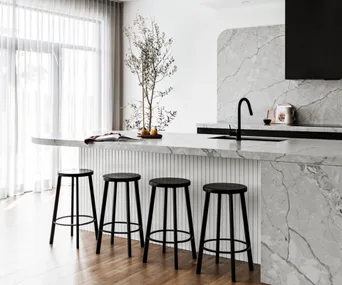It’s one of the most hard-working surfaces in your home. Here’s help to choose your material wisely and get the best kitchen benchtop material for your needs.
No longer shut away behind closed doors, modern kitchens in Australia are not only where meals are made but also where much of the action happens – from homework to household admin and from family meals to entertaining. All of which means the kitchen benchtop materials used need to be both practical and good-looking, whether you are an enthusiastic gourmand, a short-order family cook, or a takeaway connoisseur. And nothing gets a bigger workout than your benchtop.
Here’s our pick of the tough but terrific materials that will give you kitchen counter bliss.

In this heritage Sydney abode, a curved island bench is topped with marble and wrapped in ribbed timber in the light and airy kitchen.
(Credit: Photographer: Simon Whitbread | Styling: Ashley Pratt)things to consider
Hard choices
Different materials suit many different applications, so before you get swept away choosing a colour, consider how your kitchen is used. Most materials are durable and hard-wearing, but some require a little more care than others. Marble has been having a moment recently, but it’s actually fairly soft and absorbent, meaning you’re constantly on the lookout for spills, or need to accept it will show its history.
Counting pennies
Cost is a big consideration, not just for the material but also for installation. Porcelain, for example, does require specialised tradespeople. “Because it is so hard and dense, if it was dropped, it would just shatter,” says Prue Gordon, interior architect at Melbourne’s Bryant Alsop Architects. “It needs special tools to cut it and stonemasons who are happy working with engineered stone are not necessarily happy cutting porcelain.” Always make sure your estimate includes installation before you sign on the line.
Personal touches
The final step is finding a look you’ll love. Prue Gordon of Bryant Alsop Architects, takes her benchtop lead from the flooring. “It’s a case of who’s using the kitchen, whether there are kids, and what the home’s design style is,” she says. Consider too, how the colour and finish will flow throughout your home, a factor particularly important in an open-plan zone.
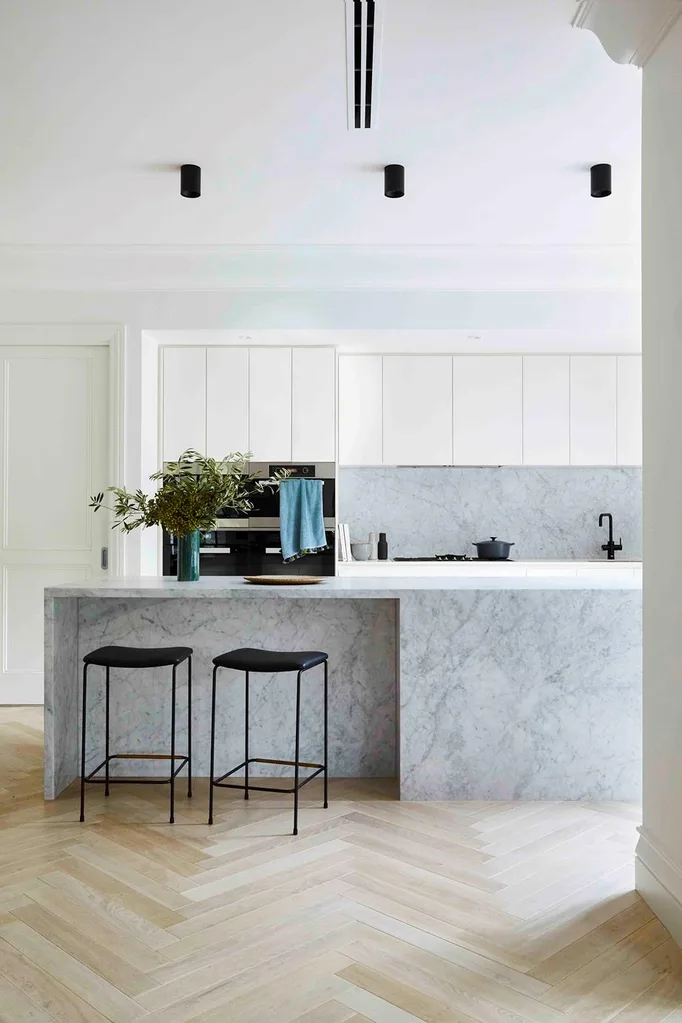
The cooking zone in this modern Spanish-style home has undergone a total transformation with luxe Carrara marble from Gladstones Granite defining the room.
(Credit: Photographer: Jackie Brygel | Styling: Julia Green)7 types to consider
1. Natural stone benchtops
The beauty of stone – such as Statuarietto marble or Juparana granite – is as a natural material, each slab is unique. Marble is popular with enthusiastic cooks as it’s perfect for rolling out pastry, but it’s easily stained by things such as red wine, vinegar, coffee, spices (we’re looking at you, turmeric!) and even water. Granite benchtops are much less porous, making them more stain- and scratch-resistant, and they come in a wide, and very beautiful, selection of colours. The finish for either marble benchtops or stone benchtops can be gloss (polished) or honed (matt) and it’s best to visit the warehouse and choose the slab you want so you know exactly what you’re getting.
Cost: Pricing depends on where the stone is from, what type it is and the thickness of the slab. Marble ranges from $800 to $2200 per square metre and granite from about $700 to $1700 per square metre, including installation, but will attract additional costs for cuts for undermount sinks, where edges need to be carefully finished. A sink cut-out usually costs $250 and drainage grooves about $350.

CDK Stone supplied the ‘Bianco Carrara’ honed marble for the benchtops and splashback in the kitchen of this Victorian charmer in Mosman.
(Credit: Photographer: Simon Whitbread)2. Stainless steel benchtops
Stainless steel is very hard-wearing and hygienic, which is why it’s used in restaurant kitchens. Splashbacks and sinks can be completely integrated, so there’s no cracks for nasties to loiter in, and going for high-grade, thicker stainless steel benches mean they can be re-polished every five to 10 years, giving you the look of a brand new benchtop. “I love stainless steel, but you have to be the type of person who’s happy with the little scratches after a couple of years,” said Prue Gordon.
Cost: For good-quality stainless steel, allow about $900 per square metre and $300 per sink.
3. Polished concrete benchtops
Concrete benchtops are formed and poured on site, and considering their weight, you may require additional sub-floor structural work for support. However, they have a wonderfully raw finish (that’s now being imitated by other materials) and can even have heating built into them. Concrete benchtops also need to be sealed before using and finishes can vary from very rough to more refined, plus they can be coloured by tinting the mix.
Cost: This is definitely a project best done by professionals and will cost about $1000 to $1750 per square metre depending on the complexity of the formwork and the finish.
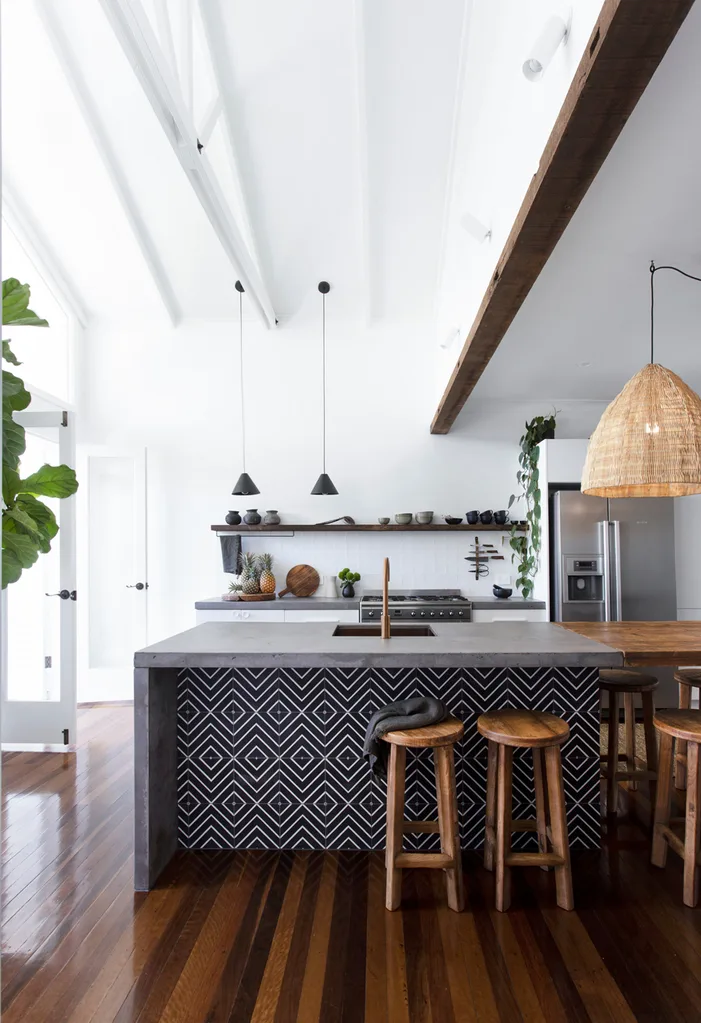
Concrete benchtops were poured on site for an island that’s a work bench at one end, with brushed copper sink and tapware, and casual dining at the other in this coastal home in Queensland. “I made it from a timber coffee table that was the perfect width,” owner Dave explains of the tactile surface.
(Credit: Photographer: Louise Roche | Styling: Kylie Jackes)4. Timber benchtops
Timber benchtops, such as American Oak top, are formed from one solid length or pieces that have been laminated together (butcher’s block style). The surface of wooden/timber benchtops needs to be finished before using and, if oiled, will absorb spills. Bamboo benchtops are on the rise in the timber market. The big advantage is every couple of years you can have it re-finished to remove any marks, and the benchtop will be as good as new. The trend, says Brett Patterson of design and project management company, The Renovation Broker, is towards timber being used as a feature on an island bench, rather than throughout the kitchen.
Cost: It depends on the type of timber you choose, and whether you go to a kitchen specialist, Bunnings or IKEA but prices range from $550 to $950 per square metre.
5. Engineered stone benchtops
Appearing under brand names including Caesarstone, Silestone, Quantum Quartz in Gobi Black and Essastone, engineered stone is made from mostly crushed quartz held together with resin, and is available in a variety of colours and finishes. It is also sold by the slab, which does limit its length to 3000mm. Joins are becoming finer, but if you are installing a longer bench or island, you will need to consider where the join falls. Brett Patterson also recommends pairing engineered stone with low-profile, flush mount sinks so cut edges aren’t chipped and damaged by pots and pans.
Cost: Prices range from $1200 per 3000mm x 1400mm slab for standard colours to $4500 per slab for premium ranges. Undermount sink cut-outs and drainage grooves will cost more.
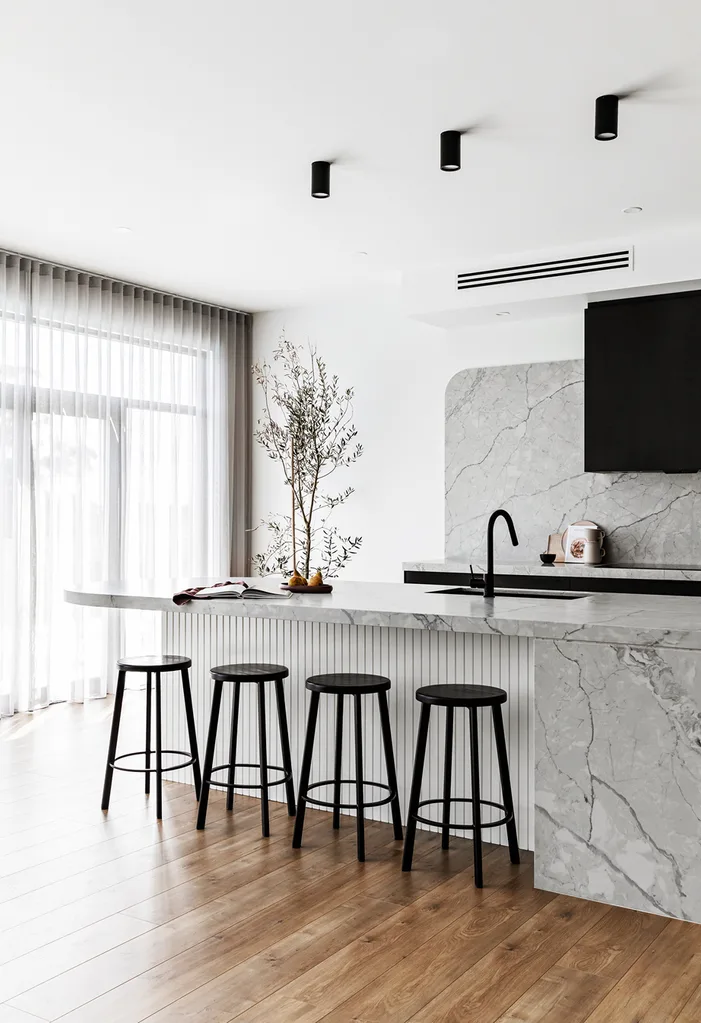
The star of the kitchen in this striking family home is the island bench, a curvy custom creation by Vision Kitchens & Joinery featuring engineered stone benchtops – Talostone in Super White – plus polyurethane VJ panelling below painted in Dulux Vivid White.
(Credit: Photographer: Nat Spadavecchia | Styling: Fiona Gould)6. Porcelain benchtops
Newly arrived on the benchtop scene, porcelain is marketed under the brand names Dekton and Neolith. Made of powdered clay and coloured pigments and bonded together at very high temperatures, porcelain can be created with different textures, from glossy to matt, and can also be printed with finishes that resemble stone, timber, concrete and rusted metal. It is extremely dense and non-porous, plus it’s very resistant to heat, which means it’s great to use around cooktops. Another advantage is it can be used outdoors, so your alfresco kitchen can have the same look as indoors. Porcelain, such as this Dekton ‘XGloss’ in Halo, is made in larger slabs than engineered stone and in much thinner profiles, tapping into the current trend away from slab-like benchtops. However, it’s extremely heavy and you will need to work with your joiner to ensure cabinetry can take the weight.
Cost: Roughly the same base cost as natural stone, but generally more for installation, as it requires specialist installers and tools.
7. Laminate benchtops
Laminates are budget-friendly and offer a seemingly endless range of colours and finishes, including marble and stone-look that are almost as good as the real thing, so try Laminex’s ‘Diamond Gloss’ in White Valencia or ‘Impressions’ in Black Spark. The major brand has also recently added an on-trend matt finish to its massive range. “It’s velvety to the touch, has limited reflectiveness and is non-fingerprint marking,” explains Catherine Valente of Laminex. “Plus, it has a really strong sense of warmth.”
“If you’re clever with your design, you can use laminates beautifully. Forget spending $8000 on a stone benchtop, let’s spend $1500 and do something amazing!,” said Brett Patterson.
Cost: Laminates are generally sold by the linear metre and in various widths (from 600mm to 1200mm), with prices from $120 per linear metre for a 600mm benchtop in a standard finish to $440 per lineal metre for a 1000mm to 1200mm benchtop in a premium finish.
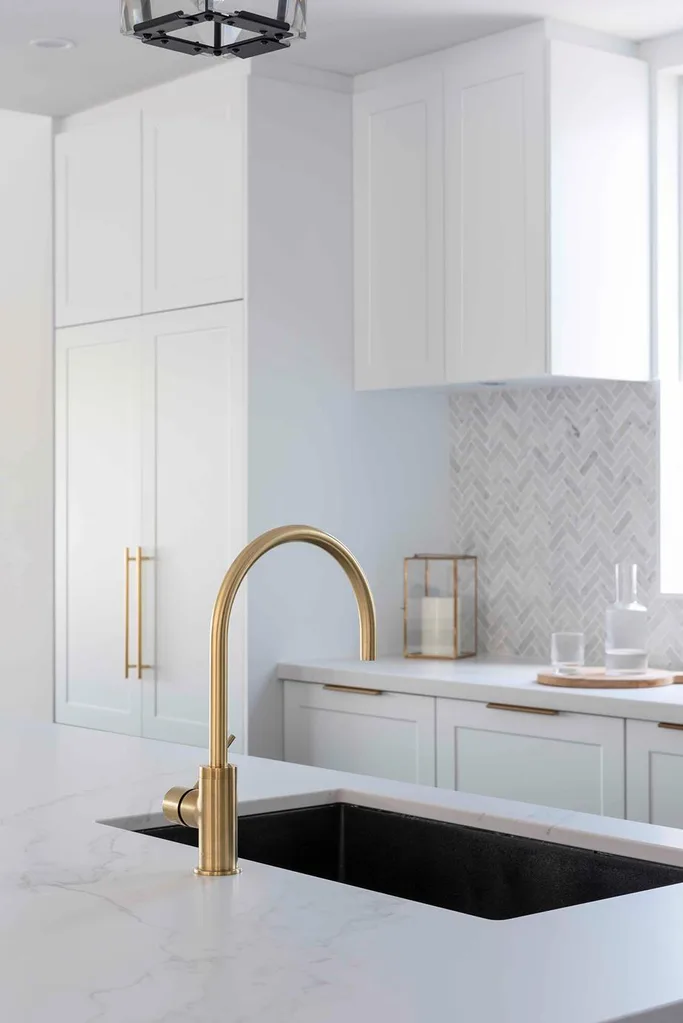
A stunning island bench that’s clad in Polytec Thermolaminate in Tempest, and then topped with Essastone in Unique Calacatta, a new laminate technology, steals the show in this Hamptons-style new-build’s monochrome kitchen.
(Credit: Photographer: Claire McFerran | Styling: Alex Carter)This article originally appeared on homebeautiful.com.au
 Simon Whitbread
Simon Whitbread
